Over the last couple years I have featured a couple of AR builds here at TTAG and elsewhere that had Russian Bakelite colored stocks and mags. Some people really loved the look of them and I have subsequently found some of my images “borrowed” and used on social media by others.
Over that time I’ve been asked just where and how I got such cool colors so, let’s get to it . . .
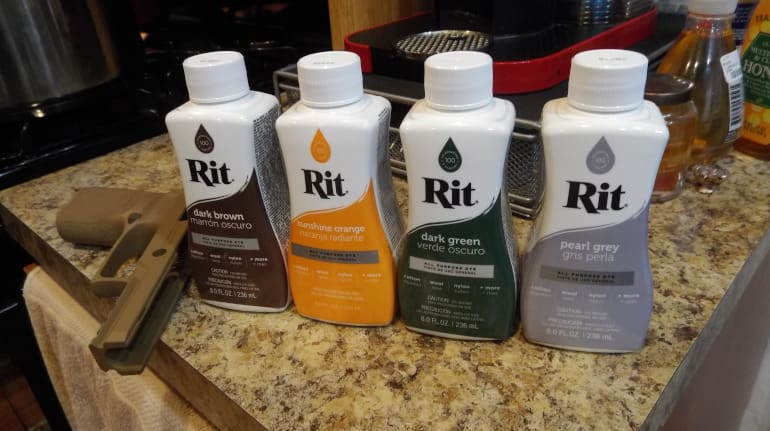
I decided to go for maximum effect and went with four colors of dye, all available at your local craft store. The brand I used was Rit. I used Sunshine Orange, Dark Brown, Pearl Grey, and Dark Green. I knew that I’d get different results when dying different polymers, so I went with parts from SIG SAUER and Magpul for some consistency.

The SIG SAUER parts I used were grip modules for the P320 and M17 pistols. I bought grips in white and FDE. I also got a variety of Magpul parts from Brownells. As you can see, the Magpul FDE is different from the SIG version. I had some older ‘sand’ colored mags that I also decided to dye.
In order to do this project you’ll need a large pot of some sort that can be put on the stove. I used a stainless steel one so that I could clean it more easily. I’d probably refrain from using an enameled version as it could possibly get stained.
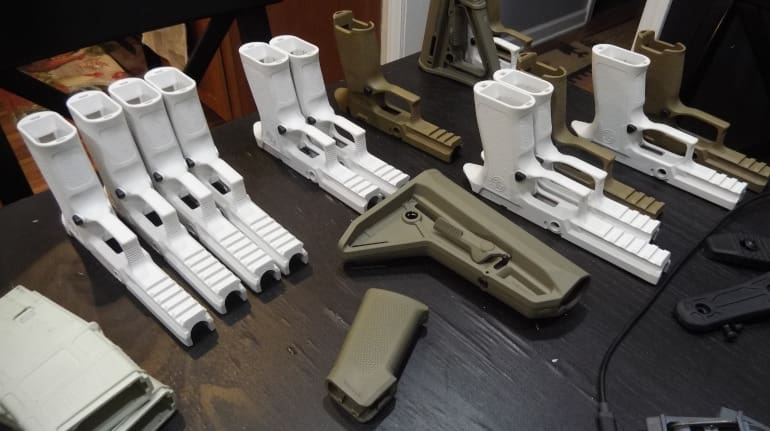
You will need to fill the pot enough to cover all your parts as they need to be fully submerged for even coverage. To two gallons of water, I added about ½ to ¾ of each dye bottle. That’s a lot, but you need enough density of the dye in the water to ensure color saturation. I add the dye as the water starts to come to a boil.
The nice thing about this project is that you don’t really have to remove any metal parts. I took the buttpads off the stocks and took the magazines apart, but an argument could be made that I didn’t need to. The dye won’t take to the metal parts.
Once the water is at a boil, you can reduce the heat slightly to a simmer. The next step is to get a pair of tongs and lower your parts into the water.
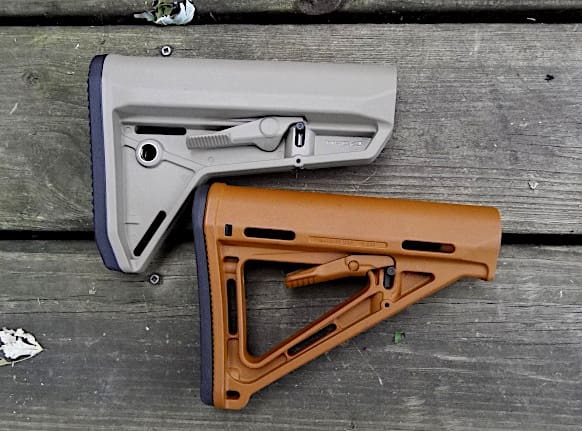
The Magpul parts take the dye almost immediately and only need to be submerged for a few minutes. If you leave your Magpul parts in too long they’ll keep absorbing color and become darker and darker.
Not the difference between the color of the magazine and its baseplate below. The baseplate was left in for much longer with the SIG parts because I couldn’t find it in the pot with the tongs. You can clearly see the difference between the various shades of green here on these two rifles.

Once removed from the water, carefully move the parts to the sink and rinse them in warm water. The excess dye will rinse right off and you can handle the parts immediately. I just let them sit out and air dry, although you can certainly dab them dry if you want.
The SIG parts didn’t take the color nearly as quickly. In fact, I had to soak all of them for about 15 to 20 minutes at a low boil to achieve good color saturation.
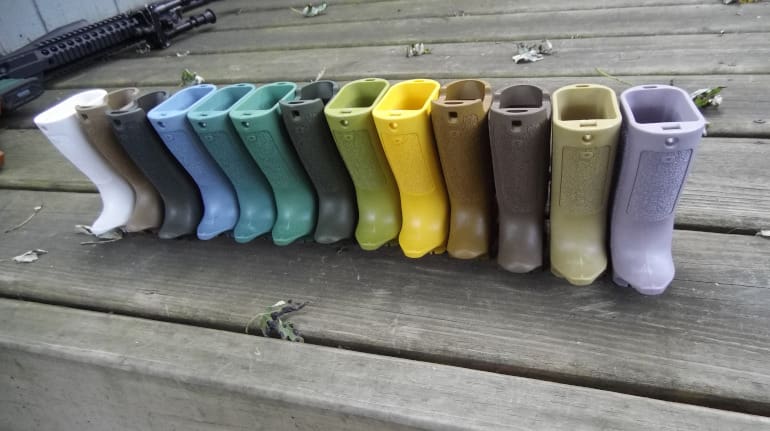
Some odd things happened. While I was expecting the results to be slightly different than the advertised color of the dye, the SIG parts didn’t absorb color the same way as the Magpul parts. The accompanying photos illustrate this quite well.
I got colors ranging from Thanos purple to avocado green. There was no telling what was going to come out when I put the SIG parts in the pot. They took the dye well, they just didn’t turn out as expected.
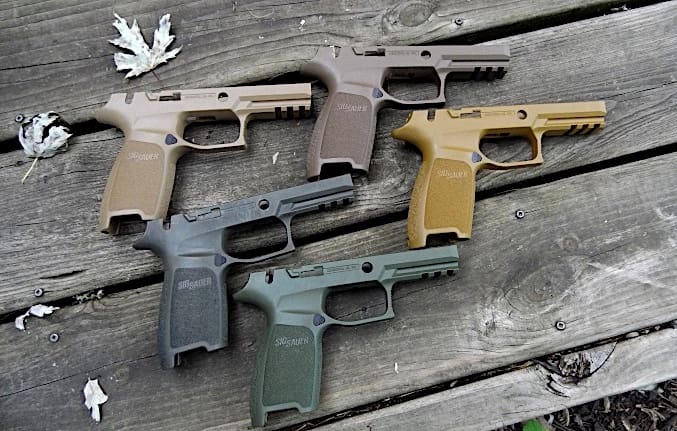
The range of results I got from one dye color surprised me. I didn’t expect to come out with such a rainbow, but I did all of this in the name of pseudo-science which makes it all worthwhile. I’ll probably take a longer look into the reasons why I got these colors at some point down the road.
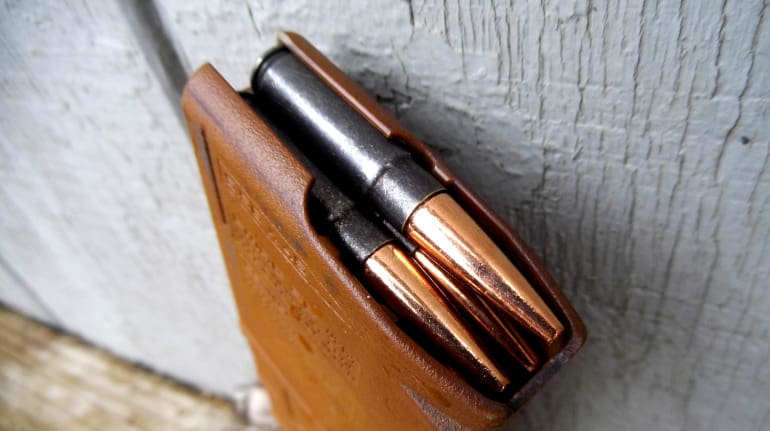
So how well does the dye hold up on the parts? Very well, actually.
I’ve been using the Bakelite-colored AR-15 parts for a couple of years now and they have not faded, rubbed off, or scratched. The feed lip area of the mags show no real wear despite those being a high-activity area.
The dye penetrated the plastic pretty deeply — this isn’t like paint — and can’t chip off. If you gouge a part deeply it can show the original color, but you really have to damage it to see that.
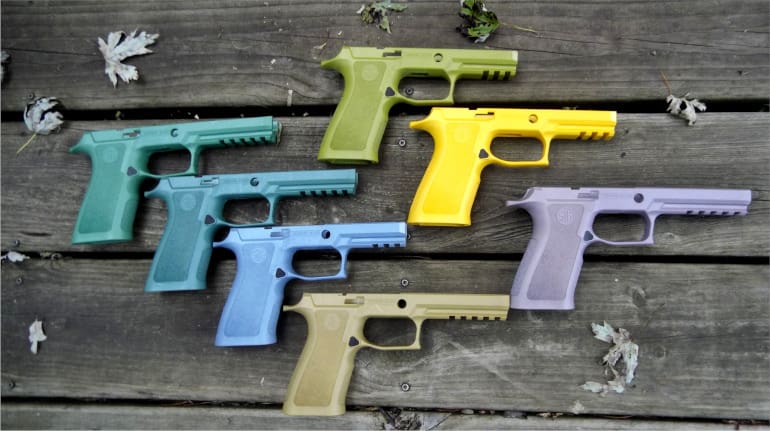
Right column: DG over SO, Sunshine Orange, and Dark Brown (aka Thanos Special) (Josh Wayner for TTAG)
This was a fun project that really doesn’t take too long. My suggestion would be to buy a couple of sample parts that you don’t mind screwing up to test first. I had no idea that I’d get the range of results I did and was surprised when Sunshine Orange dye came out a bright yellow.
There isn’t any going back once you dunk a part, so be careful and make sure you want to permanently alter a part before you begin your own project. And have fun.




All gun parts matter.
didn’t this article appear here in like 2019-2020 time frame? I’d have sworn I’ve read this before a few years back either here or someplace else else maybe.
I think you’re right but there’s likely a lot of newbies here(been around here 10 years). FWIW I like basic black gunz…
well anyway… the easier way to do this and get better color control..
skip the water…heat the dye its self in a suitable sized non-enamel non-stick non-iron pot to the point of an almost but not full boil, remove from heat. immediately dip the part in covered completely for three minutes and you get the bottle color. repeat dye heating and dip and time for deeper color.
not all polymer gun parts will take the rit dye method well, occasionally some not at all.
there are also commercially made alcohol/other chemical based ink dyes you can do this with. Mostly, those can be brushed or sprayed on.
what ever you use… make sure the polymer is clean and grease/oil free, and a little warm water and dawn dishwashing liquid and a little lite scrubbing works to do that.
Yeah, but sometimes close is good. I had grey Magpul furniture on a rifle, and got a Battlelink MFT stock in grey. It was comically different. The Rit blue denim dye did the trick and the too colors are now nearly the same. The blue on black looks really good too.
Back when I first got an M&P45 there was a magazine shortage, and all I could procure were plus-sized mags with FDE extensions and plates. I wanted them black, so I dyed them with Rit: I wound up with licorice-colored extensions, but they were close enough to suit.
Licorice IS black. That red stuff isn’t really licorice.
It’s black with a reddish tinge to it, but not solid black.
This is neat but I doubt I’ll ever do this. If anything, I might be more inclined to do this with plastic magazines (which I think is what that article was about a few years ago). Even then I’m more likely to Cerakote.
You can get a polymer pistol in almost any color you want off the shelf.i like two tone pistols. Usually black with coyote brown/desert tan (or whatever they’re calling it this week) or OD. Why would I want to light my stove?
I like my heet discreet!
Magpul needs to re-introduce sand colored AR mags (preferably as Gen 3). They were a bone white and essentially took ANY die and came out true to color. Lots of prrimers on the web on using masking and multiple die colors for camo and unique patterns.
Very nice work Josh Wayner…I bet I know who does the Easter Eggs at your house.
Some years back I did this with several 10/22 mags that started as a grey see through and I used Rit to turn them purple. This sort of thing is useful if you are going to a class and need to be able to easily identify your mags.
Never having used RIT for anything, what happens if you screw up and get the dye on your skin? Are you walking around painted until your skin sloughs off? Will it stain your sink like Kool Aid too? 🤣 Just curious.
“Never having used RIT for anything, what happens if you screw up and get the dye on your skin? Are you walking around painted until your skin sloughs off? Will it stain your sink like Kool Aid too? 🤣 Just curious.”
On skin: Well, first of all you are not suppose to take a bath in it. And second, you should be wearing gloves when you do this and exercise a little care not splash it around. But, in case you do get it on your skin you can try the following to remove it… a search engine for “remove rit dye from skin’ but if you want something quick…. bleach will remove it (or use something with bleach in it, Comet, Tilex, etc…) or you can ‘exfoliate’ it off more ‘gently’ (but takes longer) with ‘some’ body washes (that exfoliates) or some dawn dish washing liquid (or another) and a scrubbing pad (go gently).
Will it stain your sink: Yes and no. It your sink has a ‘porcelain’ or ‘enamel’ layer then yes it can stain. If your sink is a steel sink (like in the kitchen, that chromed or steel finish) then generally no. But if it does stain a little bleach will get rid of it, most times. But if its an enameled or porcelain surface and the dye is hot when it makes contact it can penetrate more deeply into the surface and can be hard to get rid of. Also watch out for counter tops as some materials used in counter tops can stain too from the rit dye. Yes, this counts for the toilet too as it can also stain that.
Or you can avoid the sink stain issue all together and just take it outside and pour it someplace in the yard. Its not going to hurt anything other than maybe some grass/weeds might get a little upset temporarily due to the ‘acids’ and sodium chloride content. I would not pour in in your garden or on your flower beds.
or…to add… mix up a thick’ish paste with some baking soda and water and use it with a scrubbing pad to ‘exfoliate’ it off.
The ‘Sunshine Orange’ stock color looks more like infant-baby-poop color after they had a Gerber baby-food mushy strained carrots dinner.
Is it possible to dye a black grip frame?
Jim Simpson,
I believe that you would have to somehow bleach a black grip frame first to lighten it and then dye it a darker color.
I have no idea if it is possible to bleach black polymer. Any organic chemists in the room?
A HiPoint spray painted gold looks really cock
Comments are closed.